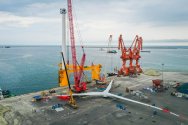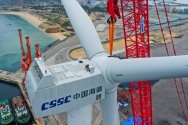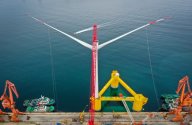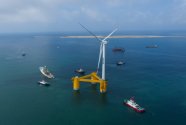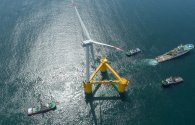You are using an out of date browser. It may not display this or other websites correctly.
You should upgrade or use an alternative browser.
You should upgrade or use an alternative browser.
Climate Change and Renewable Energy News and Discussion
- Thread starter FairAndUnbiased
- Start date
you can actually put pumped hydro anywhere you want, with an enclosed water tower. let's compare block vs water:Of course pumped hydro economically is the best one, but you cannot create pumped hydro storage everywhere. Hydro itself also has negative effect on the environment. Let's say they will have 4000 GWs of solar/wind power in operation in 25 years, how would you be able to store the excessive generation with purely pumped hydro?
They need to continue to invest in other forms of energy storage that are not as economic.
(~1x1x2 meter accounting for spacing, 2 [metric] tons), requires complicated crane and hoist system to lift, also needs complicated positioning mechanism, and the height is limited by cable tensile strength and positioning accuracy. You need spacing between each block for mechanisms.
A water tower with an underground tank for pumped hydro on the other hand: requires no complicated crane, hoist or positioning system, just tank, pipe, structural struts, check valve and pump. Pipe only needs to withstand a single force - internal pressure - instead of complex tensile forces. Pump can run continuously, so pump doesn't have high throughput requirement, only pressure requirement.
Let's take this water tower. Equivalent to 4500000 kg (4500 tons) of water. Gravitational potential energy E = mgh = 4414500000 joules = 1.23 MWh. Have a tank reservoir below ground as the storage. Cost is $16 million USD, note that the water tower contains 2 spherical sections, so the lower reservoir cost is accounted for. But that's because it's human rated with a restaurant. Without human rating and restaurant, you can probably get that down to $12 million for a 2 section water tower, even with the electrical generation equipment.
The same volume of 4500 m3 water can hold 2250 1x1x2m concrete blocks weighing 2000 kg each, each needing an individual hoist mechanism. Even if you move to monstrously sized 5x5x5m blocks (the size of a small house) you'd still need hundreds of blocks with individual hoists. And dropping a single one is disastrous. how much does concrete cost? which means just the concrete blocks cost $382,500 for materials alone, no mechanisms or even block cutting fee.
What about battery? at best, so equivalent cost to store 1.23 MWh is 123000*400 = $49,200,000. 3x more expensive than pumped hydro inside a water tower in the best case for battery, 4x more expensive in the worst case.
you can actually put pumped hydro anywhere you want, with an enclosed water tower. let's compare block vs water:
(~1x1x2 meter accounting for spacing, 2 [metric] tons), requires complicated crane and hoist system to lift, also needs complicated positioning mechanism, and the height is limited by cable tensile strength and positioning accuracy. You need spacing between each block for mechanisms.
A water tower with an underground tank for pumped hydro on the other hand: requires no complicated crane, hoist or positioning system, just tank, pipe, structural struts, check valve and pump. Pipe only needs to withstand a single force - internal pressure - instead of complex tensile forces. Pump can run continuously, so pump doesn't have high throughput requirement, only pressure requirement.
Let's take this water tower. Equivalent to 4500000 kg (4500 tons) of water. Gravitational potential energy E = mgh = 4414500000 joules = 1.23 MWh. Have a tank reservoir below ground as the storage. Cost is $16 million USD, note that the water tower contains 2 spherical sections, so the lower reservoir cost is accounted for. But that's because it's human rated with a restaurant. Without human rating and restaurant, you can probably get that down to $12 million for a 2 section water tower, even with the electrical generation equipment.
The same volume of 4500 m3 water can hold 2250 1x1x2m concrete blocks weighing 2000 kg each, each needing an individual hoist mechanism. Even if you move to monstrously sized 5x5x5m blocks (the size of a small house) you'd still need hundreds of blocks with individual hoists. And dropping a single one is disastrous. how much does concrete cost? which means just the concrete blocks cost $382,500 for materials alone, no mechanisms or even block cutting fee.
What about battery? at best, so equivalent cost to store 1.23 MWh is 123000*400 = $49,200,000. 3x more expensive than pumped hydro inside a water tower in the best case for battery, 4x more expensive in the worst case.
You are seriously going to use Tesla Powerpack to proof your point here? I love Tesla power pack. I'm probably going to buy one myself, but it's not cost efficient compared to other battery energy storage solutions. It sells well because of the coolness factor.
BYD's energy storage solutions will be a lot cheaper. I don't know if this will necessarily be as cheap as water tower, but there is no restrictions on where you can put them. Just look at how many they have sold. And the battery technology will continue to get cheaper in the future.
I haven't looked enough into this flow batteries, but they will probably be cost competitive once the technology matures.
Here is the great thing. If water tank can solve most of the grid level energy storage problems, we will see that 10 to 20 years from now.
yep we will. either dedicated water tanks or large dual use water tanks (energy storage and reservoir at same time) with turbine at the outlet probably are going to be built soon.You are seriously going to use Tesla Powerpack to proof your point here? I love Tesla power pack. I'm probably going to buy one myself, but it's not cost efficient compared to other battery energy storage solutions. It sells well because of the coolness factor.
BYD's energy storage solutions will be a lot cheaper. I don't know if this will necessarily be as cheap as water tower, but there is no restrictions on where you can put them. Just look at how many they have sold. And the battery technology will continue to get cheaper in the future.
I haven't looked enough into this flow batteries, but they will probably be cost competitive once the technology matures.
Here is the great thing. If water tank can solve most of the grid level energy storage problems, we will see that 10 to 20 years from now.
yep we will. either dedicated water tanks or large dual use water tanks (energy storage and reservoir at same time) with turbine at the outlet probably are going to be built soon.
thus far, it seems like all of their projects have been the conventional type with 1 reservoir on the top and one on the bottom.
Keep in mind that BYD's LFP blade battery costs well under $100/kwh. New technology in the future will probably lower the cost even more than that. And there is no restrictions on where you can place these battery boxes. That would actually kill the business case for water tower pumped hydro. So, I'm skeptical that it would work. I think you are going to end up with a case of pumped hydro (with 2 reservoirs) for most of the energy storage and lithium/sodium ion battery for a big chunk and other technologies like flow battery for the remaining.
Possible but my point is that concrete block based energy storage just isn't going to work. It is the worst of both worlds being much more expensive and complicated than both water tower and battery based electricity storage.thus far, it seems like all of their projects have been the conventional type with 1 reservoir on the top and one on the bottom.
Keep in mind that BYD's LFP blade battery costs well under $100/kwh. New technology in the future will probably lower the cost even more than that. And there is no restrictions on where you can place these battery boxes. That would actually kill the business case for water tower pumped hydro. So, I'm skeptical that it would work. I think you are going to end up with a case of pumped hydro (with 2 reservoirs) for most of the energy storage and lithium/sodium ion battery for a big chunk and other technologies like flow battery for the remaining.
yep we will. either dedicated water tanks or large dual use water tanks (energy storage and reservoir at same time) with turbine at the outlet probably are going to be built soon.
Pumped hydro storage works if you already have favourable terrain (volume x height differential)
But if you have to build your own water towers, the costs will kill the project.
Look at the Fengning figures (40 million m3 x 425 metres) as as example and see how much a water tower equivalent would cost.
I expect the water towers to be far more expensive.
I get a figure of $46 per KWh of storage capacity for Fengning, but we can expect batteries to beat this in 5-10 years time.
Last edited:
supercat
Colonel
When Elon Musk said that China was the world leader in renewable energy, he was 100% correct. This year, China will build the equivalent of one coal-fired power station a week with wind and solar power. The solar power capacity China will add this year is equivalent to the solar power capacity in the U.S. in total.
How big of deal is this, what can China gain from lackey South korea?
Is this purely for market acces in SK?
Mingyang will become big player 2023-24 since their MYSE 264-16 will become mass prosucable, becoming largest single wind turbine with 16MW.
Would be sad if SK's steal this tech.

